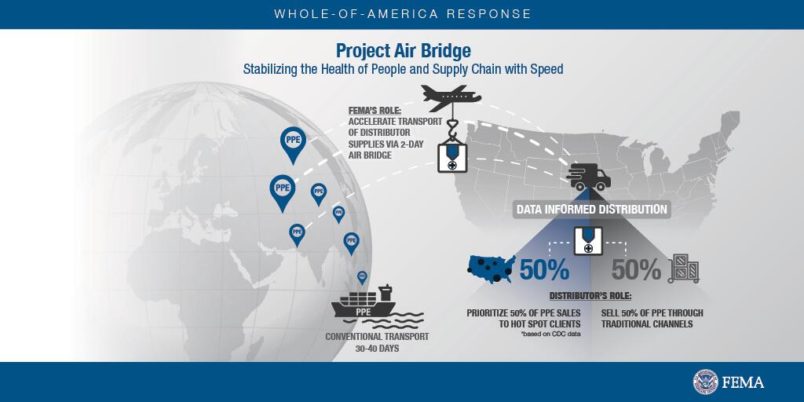All month we’ve been talking about Project Air Bridge, the federal government organized airlift of medical supplies which are then handed over to private sector distributors to distribute around the country. A few media reports have suggested, often on the basis of unnamed sources, that there is a 50-50 deal. The distributors agree to route 50% of the supplies to hotspots as defined by FEMA while the other 50% they can sell on an ordinary commercial basis. But we don’t have to rely on these reports. An April 8th FEMA bulletin, flagged to me by TPM Reader GG, lays it all out pretty clearly. There’s even a handy graphic.
To quote the April 8th bulletin: “Per agreements with distributors, 50 percent of supplies on each plane are for customers within the hotspot areas with most critical needs. The remaining 50 percent is fed into distributors’ normal supply chain to their customers in other areas nationwide. HHS and FEMA determine hotspot areas based on CDC data.”
Clear enough.

The early reports gave some people the impression that the federal government was purchasing the supplies and then handing them over to private distributors to sell within the United States. In other words, tax payers pay twice: first through their federal taxes and then again when a state or local hospital purchases them. The FEMA bulletin doesn’t explicitly address this. But my impression at least is that that is not the case. What seems to be happening is that the private distributors purchase the goods abroad – usually in East Asia. The federal government assumes the responsibility and, critically, the cost for shipment. Picking up the tab for shipment is clear: “FEMA covers the cost to fly supplies into the U.S. from overseas factories, reducing shipment time from weeks to days.”
I had thought this effort was based on US military flights. But that is not the case. FEMA is working with carriers like UPS and other smaller carriers and subcontractors to charter flights.
What’s left unexplained in all this is what the distributors do with the materials they are allowed to sell at their own discretion. Reports from state government suggest that these materials are simply being sold to the highest bidder. But these distributors are mostly the ones who supply the ordinary market in normal times. So they have customers and customer relationships to manage and keep in mind. About this, we know nothing. The FEMA bulletin also explicitly refers to “agreements” with the medical supply distributors. But those have not been made public.





